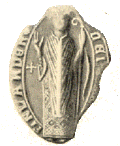Henry (bishop of Finland)
| Henry, Bishop of Finland | |
|---|---|

Henry walking on his murderer. Painting from the Church of Taivassalo about 1450.
|
|
| Bishop, missionary, martyr | |
| Born | England |
| Died | Traditionally January 20, 1156 Lake Köyliö in Finland |
| Venerated in |
Roman Catholicism, Lutheranism, Anglican Communion |
| Canonized | Pre-congregation |
| Major shrine | Earlier Cathedral of Turku, today only Catholic Cathedral of Helsinki |
| Feast | January 19 |
| Patronage | Catholic Cathedral of Helsinki |
| Controversy | Existence disputed |
| Christianization of Finland |
|---|
 |
| People |
| Bishops: Thomas · Henry |
| Rodulff · Fulco · Bero |
| Popes: Alexander III |
| Innocent III · Gregory IX |
| Archbishops: Anders |
| Valerius |
| Others: Birger Jarl |
| Sergius · Lalli · King Eric |
| Locations |
| Kokemäki · Köyliö |
| Nousiainen · Koroinen |
| Turku Cathedral |
| Events |
| Finnish-Novgorodian wars |
| First Swedish Crusade |
| Second Swedish Crusade |
| Third Swedish Crusade |
Henry (Finnish: Henrik; Swedish: Henrik; Latin: Henricus; died c. 20 January 1156) was a medieval English clergyman. He came to Sweden with cardinal Nicholas Breakspeare in 1153 and was probably designated to be the new Archbishop of Uppsala, but the independent church province of Sweden could be established only in 1164 after the civil war was over, and Henry would have been sent to organize the Church in Finland, where Christians had existed already at least two centuries. According to legend, he entered Finland together with King Saint Eric of Sweden and died as a martyr, becoming a central figure in the local Roman Catholic Church. However, the authenticity of the accounts of his life, ministry, and death are widely disputed and there are no historical records of his death nor existence.
Together with his alleged murderer Lalli, Henry remains one of the most recognized people from the early history of Finland. His feast is celebrated by the majority Lutheran Church of Finland, as well as by the Roman Catholic Church of Finland. He is commemorated in the liturgical calendars of several Protestant and Anglican churches.
The legend of Bishop Henry's life, or his Vita, was written at the end of the 13th century. It contains little concrete information about Henry. He is said to have been an English-born bishop in Uppsala at the time of King Eric the Saint of Sweden in the mid-12th century, ruling the peaceful kingdom with the king in heavenly co-existence. To tackle the perceived threat from the non-Christian Finns, Eric and Henry were forced to battle them. After they had conquered Finland, baptized the people and built many churches, the victorious king returned to Sweden while Henry (Henricus) remained with the Finns, more willing to live the life of a preacher than that of a high bishop.
...
Wikipedia
